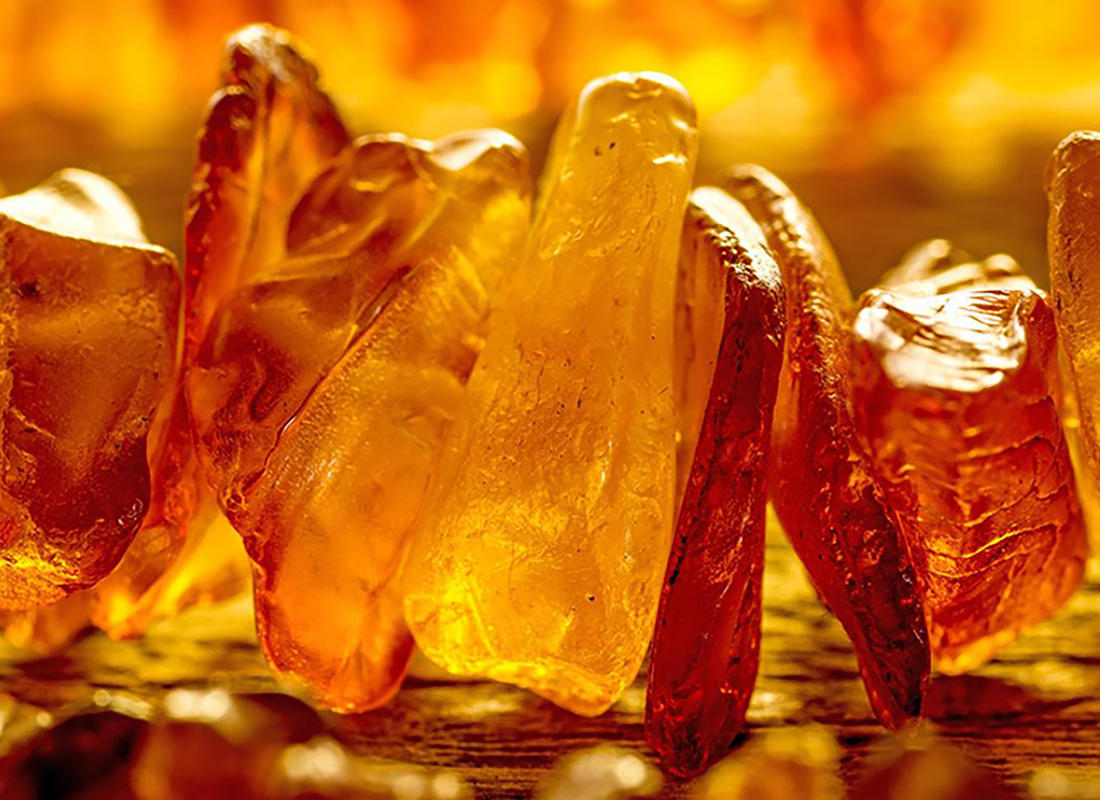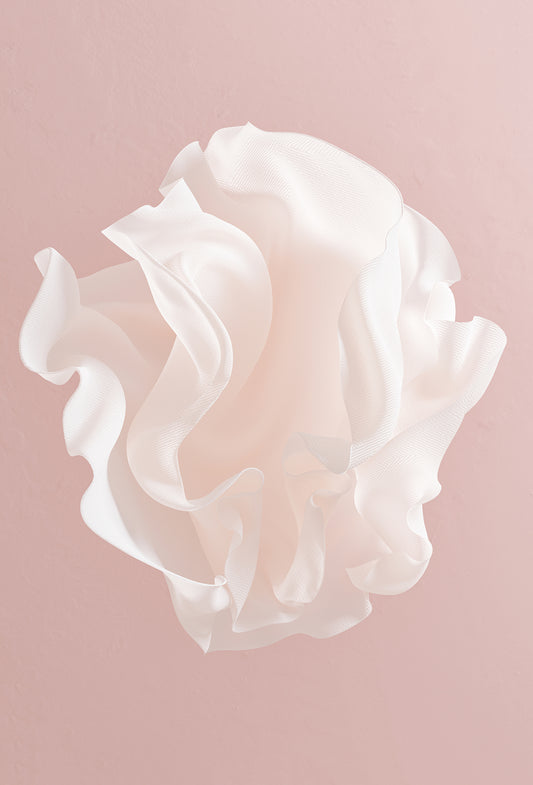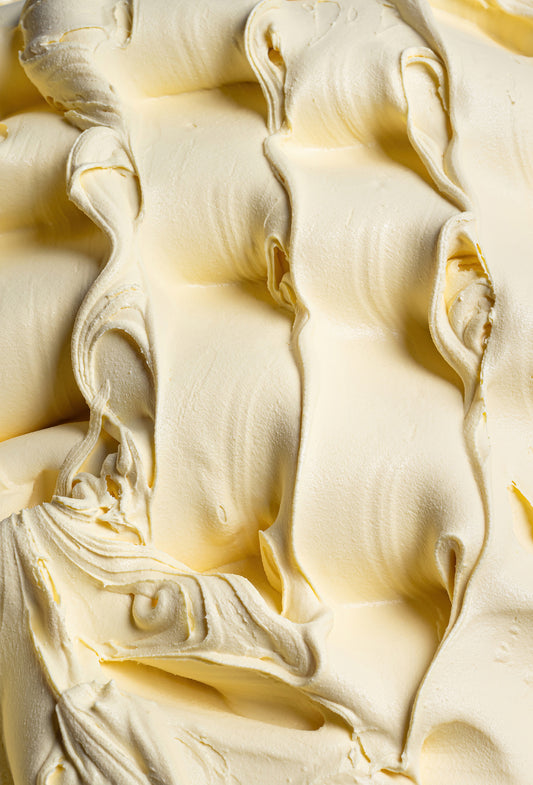Amber is one of the most valuable odours in perfumery. It comes in three main varieties, with the first (resinous) being key to oriental type fragrances. Resinous ambers are mostly built around labdanum with some contributions from other gums and ambrette seed.
This article explains the types of amber and should help you decide which products are best suited to your needs.
1. Resinous Types

Fossilized resin (amber) is usually odourless. However the beauty of the material has inspired perfumers through history to produce fantasy bases that represent what amber would smell like if it had a scent.
These are usually built on large doses of resins like labdanum and benzoin with high amounts of citrus (often bergamot or sweet orange) and vanilla (frequently balanced with coumarin and heliotropin).
These bases are usually the cornerstone of oriental perfume types, but they can also be used simply as a sweetener or for complexity. Fraterworks produces five classic ambers of this type.
i. Ambreine / Ambreine Natural
This is the famous Ambreine Samuelson base which emerged in the first decade of the 20th century. It was created by fragrance chemist Samuelson and became a firm favourite of perfumers in the golden age. It is composed around an overdose of resins with a strong tonka bean nuance.
Ambreine Samuelson was used in: Guerlain's Shalimar, Samsara, Jicky, L'Heure Bleue, Après l'Ondée, Vol de Nuit and others, including most recently Heritage in 1992. It was also found in Emeraude, Chypre and L'Origan by Coty and Habanita by Molinard, Dans la Nuit by Worth, Ungaro and Ungaro II for Men, Romeo & Gigli for men, Must by Cartier, Obsession by Calvin Klein and so many more.
Ambreine creates a synergy with Opoponax Doux, another classic base discussed below.
ii. Ambreol
Ambreol is really a vanilla base but the high amount of resins and citrus put it firmly in the amber category. This base is similar in function to Ambreine but with a decididely vanillic tonality. It was created by Roure and was also highly popular during the golden age where it was a key feature of Tabac Blond by Caron, Je Reviens by Worth, Miss Dior and Chanel No 5 in combination with De Laire's Ambre Solide. Fraterworks will be launching a restoration of Ambreol in the near future.
iii. Ambre Solide
This is the famed Amber 83 of De Laire in its original form as a solidified amber. A later version was released which was in liquid form but this solid base was the version used in Chanel's No 5 and Bois Des Ïles, and numerous other golden age fragrances. It is a rich labdanum base loaded with sweet crystallines and luxurious pure and natural floral oils and absolutes. We recently launched our restoration of Ambre Solide.
iv. Opoponax Doux
Opoonax bases differ from amber bases (though they are still within the category) in that while an amber base is erogenous, an opoponax base is narcotic. This is part of what creates the synergy with Ambreine. Opoponax bases (not to be confused with the resin of the same name) are also constructed around resins and crystallines but in different quantities and with different types to give a drier quality. Whether in combination with Ambreine or alone, an opoponax base is a vital tool for perfumers.
v. Ambre Royale
This is a highly modern Ambre 83 Liquid type of base. It is enriched with florals and naturals but at its heart is a classic vanilla and resin base. More suited to modernist perfumery due to its very fine quality, this is a must have addition to the perfumer's palette.
vi. Ambreine Rustica
Ambreine Rustica is the closest thing you will find to a top-note oriented amber base. Despite this, it is still loaded with resins, natural woods, vanilla and tonka beans. This was a favourite of Coty who recognised in it the complete skeleton of luxurious fougere. He simply floralised it, added musk, and released it as La Fougeraie au Crépuscule. It was to be his last creation before his death.
vii. Opoponax 216
Opoponax 216 was created for Chuit Naef & Cie in the late 19th century. In this opoponax base the resins and vanilla take the focus while the woody and animalic notes sit quietly in the background. Featured in the original Jicky (though it was later replaced by Opoponax Doux) and Arpège by Lanvin.
2. Ambergris Types

Ambergris type ambers are either bases or single molecules which seek to impart the qualities of natural ambergris. Historically fantasy bases such as Grisambrol filled the void left by scarcity or cost of natural ambergris.
Single molecule ambers are those which replicate part of the power of real ambergris; they are often found as constituents in the natural oil. Ambrinol provides the intensely fecal quality of the substance whilst ambrox (and its many variants) provides radiance and a woody odour — the scent most would associate with the term amber.
Ambrox itself comes in different forms. The greatest is the captive Ambrox Classique which is not available outside of Firmenich except as a 10% dilution in Fixateur 404® (Fixateur 505® replaces it was a dilution of Cetalox®, another ambrox variant). Once used only in trace amounts, Ambrox is now often overdosed, as in the most famous case of Aventus by Creed which features 11% of pure Ambrox Classique, making it a fragrance impossible to replicate exactly.
Fraterworks Absolute Ambergris™ is a scientifically accurate reconstruction of pure ambergris resin. It is equal to the finest decades-old ambergris in terms of fixative power, radiance and odour profile. It is a must have for all perfumers.
3. Woody Types
i. Amber Woods
The woody types of amber are ubiquitous today. They are Iso E Super and its many variants, including the rich Anthamber® of Firmenich and Timbersilk® (AKA Iso G Super) by IFF.
These woody ambers are most often used as a foundational filler in combination with white musks and hedione, with the three often comprising over 40 or 50% of a finished fragrance. Their scent is often boosted by newer molecules, the so-called super ambers.
ii. Super Ambers
The super ambers are now following the same path as Ambrox, in that they have gone from being commonly used in traces to being overdosed. They are the radiant molecules that are perceptible in amounts below 0.1% of a fragrance.
Key in this category are Ambrocenide, AmberXtreme, Z-11 and to a lesser degree normlimbanol (used at an 11% overdose in Boccanera by Orto Parisi.)






